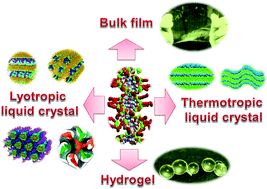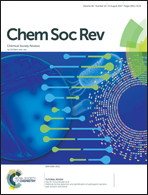DNA–surfactant complexes: self-assembly properties and applications
Abstract
Over the last few years, DNA–surfactant complexes have gained traction as unique and powerful materials for potential applications ranging from optoelectronics to biomedicine because they self-assemble with outstanding flexibility spanning packing modes from ordered lamellar, hexagonal and cubic structures to disordered isotropic phases. These materials consist of a DNA backbone from which the surfactants protrude as non-covalently bound side chains. Their formation is electrostatically driven and they form bulk films, lyotropic as well as thermotropic liquid crystals and hydrogels. This structural versatility and their easy-to-tune properties render them ideal candidates for assembly in bulk films, for example granting directional conductivity along the DNA backbone, for dye dispersion minimizing fluorescence quenching allowing applications in lasing and nonlinear optics or as electron blocking and hole transporting layers, such as in LEDs or photovoltaic cells, owing to their extraordinary dielectric properties. However, they do not only act as host materials but also function as a chromophore itself. They can be employed within electrochromic DNA–surfactant liquid crystal displays exhibiting remarkable absorptivity in the visible range whose volatility can be controlled by the external temperature. Concomitantly, applications in the biological field based on DNA–surfactant bulk films, liquid crystals and hydrogels are rendered possible by their excellent gene and drug delivery capabilities. Beyond the mere exploitation of their material properties, DNA–surfactant complexes proved outstandingly useful for synthetic chemistry purposes when employed as scaffolds for DNA-templated reactions, nucleic acid modifications or polymerizations. These promising examples are by far not exhaustive but foreshadow their potential applications in yet unexplored fields. Here, we will give an insight into the peculiarities and perspectives of each material and are confident to inspire future developments and applications employing this emerging substance class.



 Please wait while we load your content...
Please wait while we load your content...